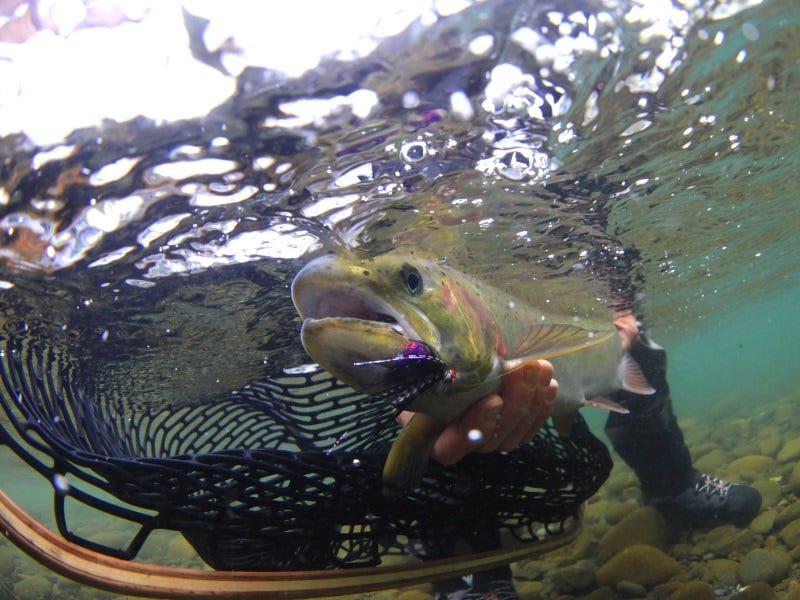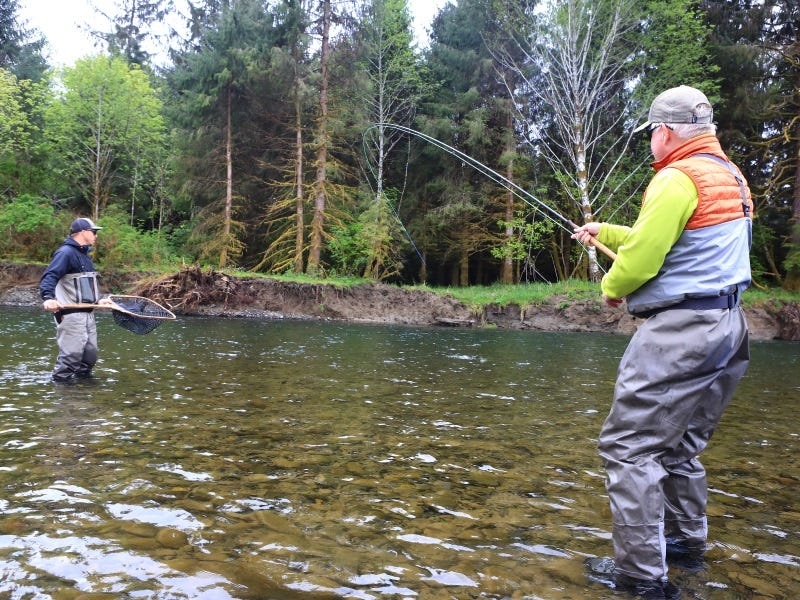Road Trip: “Early-Run” Winter Steelhead on Washington’s Olympic Peninsula

By Dave McCoy

Do You Need A Guide to Catch Olympic Peninsula Steelhead
Summer trout fishing is on its long gone, and shorter days bring steelhead to mind on a daily basis. This may be the case for you, too. And, if so, I wouldn’t doubt you’re thinking that Washington’s notorious Olympic Peninsula is a worthy destination . . . for many reasons, not the least being a shot at some big, wild steelhead fresh in from the ocean. “Done,” you might be saying right now. “The OP it is.”
When Can I Catch Winter Steelhead on the OP
If that’s the case, there are several things you need to consider before stringing a rod and starting to huck. First, timing is everything, as this is a rainforest that gets more than a hundred inches of rain a year, guaranteed. In addition, remember that every river here is a freestone—meaning no dams—and they rise and fall with the nuances of the weather. When you fish the OP you may start using the catchphrase, Fluctuation happens. Ideal conditions offer a river on the drop, after a freshet. But, even the greatest weather forecasters can blow a diagnosis, so the only way to know what’s really happening on these rivers, at any given time, is to be there and endure whatever you find.
Hatchery fish arrived as early as late November on the Bogachiel. These should be followed silently by wild steelhead in late December and throughout January. These wild fish, which average about eight-to 12 pounds, with some giants thrown in that measure past the 40-inch mark, are somewhat ignored during this timeframe. In fact, most fly fishers don’t get too excited about the possibility of wild fish until January passes. So, if you’re looking for a chance at some great fish, with less competition than you’ll find later in the season, and you get a window of favorable flows, mid-to late January can be primetime.

DIY for Olympic Peninsula steelhead
If you’re going DIY on the Peninsula and have a boat, you’ll cover more great water than you could ever effectively fish in season, let alone during a long weekend. However, these rivers aren’t for sissies. Nor are they for the mindless. Take note: After each big rain new debris flows down the river, including giant tress that may stretch across these rivers. Driftboats are a great tool to cover lots of water, but on the upper reaches of the Hoh and the Bogie, among others, you may want to take a raft or pontoon that can be easily portaged around obstructions.
If you don’t have a boat, don’t throw in the towel—you can wade-fish these rivers and cover good water, too. In fact, with a gazetteer and Google Earth, you can pick your way around the upper Bogachiel, Hoh and Sol Duc rivers on your own with relative ease. But these rivers are big and can be intimidating. That’s why spey rods are such a good idea on these broad rivers. My personal stick of choice is something in the 11’ 6”-to 13’ 6” range, in 7 or 8-weight. That length and weight is perfect for swinging flies. Because you’re after winter steelhead in big rivers that may be running nearly bank-full, you’ll likely throw big, heavy flies off sink-tips. To turn over these flies and tips you’ll want to throw a compact Skagit head. Or, if you’re throwing a slightly shorter rod you may want a “spey/switch” head. Depending on flows you may throw a tip anywhere in the T-7 to T-18 range. You’ll need several of these tips and have them cut, or cut them yourself, in lengths ranging between eight and 16 feet long.
Best flies for Olympic Peninsula steelhead
You’ll also want your personal and customized flies for these rivers because that will give you confidence, even if you’ve fished a few days without a grab. My feeling is this: fish what you have confidence in, and for me that is usually something with black in it. For a baseline, your preferred color of Intruder should suffice.
Guided on the Olympic Peninsula
You don’t have to go all DIY on these rivers. In fact, booking a guide always is a great way to go—they are on the water every day, they know the nuances of the water and the fish at various flows on each of these rivers, and they can expedite your OP learning curve. If you hire a guide, make sure they know you want to swing flies.
What an early-season trip to the OP really offers is the state of mind you can achieve while pursuing these majestic fish. Get past the minutia of which heads and tips you need, how long the leader should be, and which waders you should wear, and get down to what matters—fly fishing for big, chrome-bright wild steelhead in a coastal rainforest, trees adorned with moss, Roosevelt elk and blacktail deer ghosting in and out of the mist, bald eagles whistling overhead, and a push of water against those waders, all headed downhill to crash into the Pacific.
On the OP—as it is when fishing steelhead wherever you find them—time passing between casts allows the mind to wander and wonder. Eventually you'll come tight, usually when you least expect it, a moment when you have to wonder, is it a rock, a limb, or a fish? When you feel that head-shake, and line peels from the reel with the turn, all your mental investment, all your wondering, all your time doubting—whether you get the fish to hand or not—is legitimized.
Book your OP trip: www.emeraldwateranglers.com
206-708-7250
